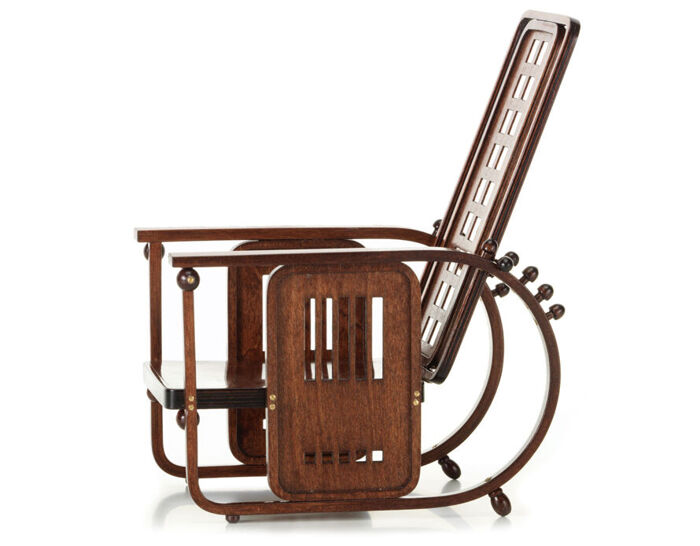miniature sitting machine
from Vitra.
miniature sitting machine
Design Hoffmann, 1905
1/6 miniature scale model
Made in Poland by Vitra
For over two decades, the Vitra Design Museum has been making miniature replicas of milestones in furniture design. The Miniatures Collection encapsulates the entire history of industrial furniture design - moving from Historicism and Art Nouveau to the New Objectivity of Bauhaus and Radical Design, and from Postmodernism all the way up to the present day. Exactly one sixth of the size of the historical originals, the chairs are all true to scale and precisely recreate the smallest details of construction, material and color. The high standard of authenticity even extends to the natural grain of the wood, the reproduction of screws and the elaborate handicraft techniques involved. This has made the miniatures into popular collector's items as well as ideal illustrative material for universities, design schools and architects.
Around 1900, the Viennese architects discovered a new means of expression in the bentwood technique. To them, the simple forms of classic bentwood furniture - a consequence of industrial production - anticipated the new aesthetic clarity they were promoting.
Josef Hoffmann's Armchair No 670 combines the austere elegance of bentwood with the expressive formal vocabulary of the Viennese Secession. Its somewhat voluminous form, strict geometry, and adjustable back are attributes that suggest associations with the machine.
Each Vitra miniature is true to the original in construction and materials, and reduced in size on a scale of 1:6. Each miniature is packaged in a wooden box, accompanied by an informational booklet. Production notes: Each of the delicate objects are made by hand; on average, each miniature requires five hours of careful manual work. Ongoing quality control ensures that every miniature corresponds to its larger original in terms of finishing, details and materials.
7.25" h | 4.4" w | 5.75" d
1/6 miniature scale model
Made in Poland by Vitra
For over two decades, the Vitra Design Museum has been making miniature replicas of milestones in furniture design. The Miniatures Collection encapsulates the entire history of industrial furniture design - moving from Historicism and Art Nouveau to the New Objectivity of Bauhaus and Radical Design, and from Postmodernism all the way up to the present day. Exactly one sixth of the size of the historical originals, the chairs are all true to scale and precisely recreate the smallest details of construction, material and color. The high standard of authenticity even extends to the natural grain of the wood, the reproduction of screws and the elaborate handicraft techniques involved. This has made the miniatures into popular collector's items as well as ideal illustrative material for universities, design schools and architects.
Around 1900, the Viennese architects discovered a new means of expression in the bentwood technique. To them, the simple forms of classic bentwood furniture - a consequence of industrial production - anticipated the new aesthetic clarity they were promoting.
Josef Hoffmann's Armchair No 670 combines the austere elegance of bentwood with the expressive formal vocabulary of the Viennese Secession. Its somewhat voluminous form, strict geometry, and adjustable back are attributes that suggest associations with the machine.
Each Vitra miniature is true to the original in construction and materials, and reduced in size on a scale of 1:6. Each miniature is packaged in a wooden box, accompanied by an informational booklet. Production notes: Each of the delicate objects are made by hand; on average, each miniature requires five hours of careful manual work. Ongoing quality control ensures that every miniature corresponds to its larger original in terms of finishing, details and materials.
7.25" h | 4.4" w | 5.75" d
(This item is currently on a production hold from Vitra due to a supplier issue. Please reach out to Hive with any questions.)
Vitra is a Swiss company dedicated to improving the quality of life through the power of design. A central goal of Vitra is sustainable development. Trendy styling is avoided in favor of classic pieces that can be used for decades.












 write a review now
write a review now